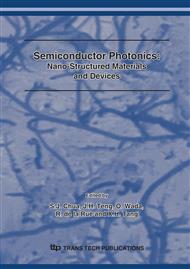p.65
p.68
p.71
p.74
p.77
p.80
p.83
p.86
p.89
Nitrogen Interstitial Defects in GaNAs Films Grown by MOCVD
Abstract:
Photoluminescence (PL) measurement shows an additional peak with stronger and broader emission at lower photon energy besides the energy band gap transition emission from GaNAs epilayer grown by MOCVD. This emission is assigned as nitrogen-nitrogen interstitial defect related emission. Effect of V/III ratio during the MOCVD growth on this defect related emission peak has been investigated. The combination of optimum V/III ratio during the MOCVD growth and post-growth rapid thermal anneal (RTA) can eliminate this defect emission peak and at the same time the GaNAs’ band gap emission has been greatly improved. The PL spectra contain a single, narrow, and high intensity GaNAs’ band gap transition emission after the RTA annealing. The optimum V/III ratio for growing the GaNAs films with N content < 3.5% is around 20.
Info:
Periodical:
Pages:
77-79
Citation:
Online since:
November 2007
Authors:
Keywords:
Price:
Сopyright:
© 2008 Trans Tech Publications Ltd. All Rights Reserved
Share:
Citation:


